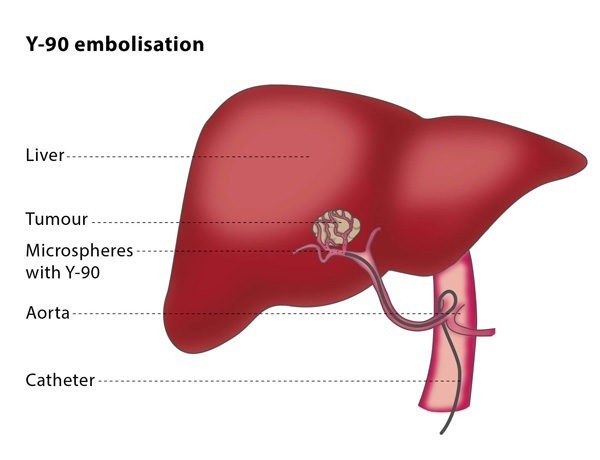You will be given a local anaesthetic. After this, the interventional radiologist will insert a catheter (a thin tube) and a guidewire into an artery. You will then have some images taken of your upper abdominal arteries to show the exact location of the vessels feeding the tumour. The interventional radiologist will then insert microspheres filled with Y-90 into these vessels to deliver a high dose of radiation to the cancer cells. This radiation dose will decrease over the following two weeks.
Your vital functions will be monitored during the procedure. You may be given antibiotics to prevent infection, and, if necessary, IV analgesics or medication to prevent nausea.
Why perform it?
If you have an inoperable liver tumour or if you are not fit for surgery, you may benefit from Y-90 radioembolisation. Y-90 is beneficial for hepatocellular carcinoma (the most common type of cancer) affecting the portal vein of the liver, or if you have not responded to chemoembolisation.
Because the radiation dose is delivered directly to the tumour, the dose is higher than in standard radiation therapy and there are fewer possible complications. Radioembolisation can extend the patient’s life expectancy from months to years, as well as improving quality of life. In some patients, this procedure enables them to undergo surgery or liver transplantation.
What are the risks?
Y-90 radioembolisation is a relatively safe procedure. The most common complication is post-radioembolisation syndrome, which occurs in around 50% of patients. Symptoms include fatigue, low-grade fever, nausea, vomiting and abdominal discomfort.
Less common complications include a build-up of fluid, high levels of alkaline phosphatase and infection. You may also experience stomach ulcers, inflammation of the pancreas, raised blood pressure, gallbladder inflammation or pneumonia. As with all percutaneous procedures, there is a risk of bleeding or damage to a blood vessel.
In some cases, patients react to the iodinated contrast materials used in the procedure, experiencing allergic reactions and harmful effects on the kidneys.
Bibliography
1. Mahnken AH, Spreafico C, Maleux G, Helmberger T, Jakobs TF. Standards of practice in transarterial radioembolization. Cardiovasc Intervent Radiol. 2013 Jun; 36(3):613-22.
2. Kennedy A, Nag S, Salem R, Murthy R, McEwan AJ, Nutting C, Benson A 3rd, Espat J, Bilbao JI, Sharma RA, Thomas JP, Coldwell D. Recommendations for radioembolization of hepatic malignancies using yttrium-90 microsphere brachytherapy: a consensus panel report from the radioembolization brachytherapy oncology consortium. Int J Radiat Oncol Biol Phys. 2007 May 1; 68(1):13-23.

